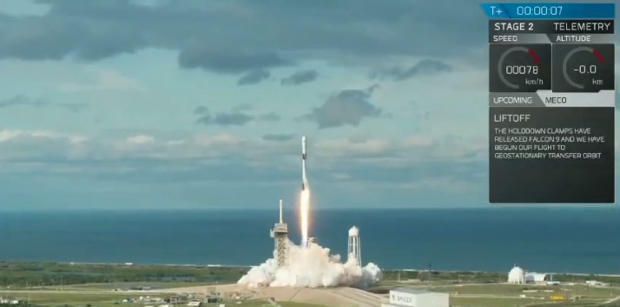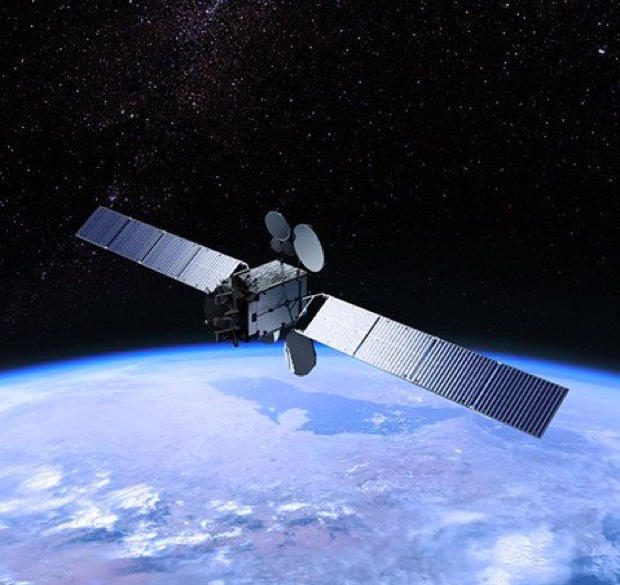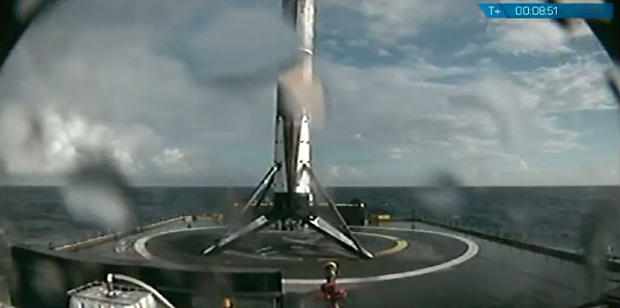Last Updated Nov 15, 2018 4:47 PM EST
SpaceX launched a Falcon 9 rocket powered by a previously flown first stage Thursday, lifting Qatar's Es'hail 2 communications satellite into orbit in the California rocket-builder's 18th launch so far this year. In an increasingly routine feat, the booster's first stage fell away and flew itself back to a pinpoint touchdown on an off-shore drone ship, the company's 31st successful recovery.
The stage first flew last July when it helped boost a Telstar communications satellite into orbit. The booster is one of six "block 5" stages launched so far by SpaceX featuring a variety of upgrades to improve performance and enable multiple flights.
When the booster launched Thursday might fly again is not yet known, but SpaceX founder Elon Musk has said the block 5 version is designed to fly up to 100 times with overhauls every 10 launches or so. Another Falcon 9, scheduled for launch Monday from Vandenberg Air Force Base, California, will be the first to fly three times.
While important to SpaceX's business model, booster recoveries remain a strictly secondary objective.

SpaceX Falcon 9 rocket launches from Florida's Kennedy Space Center on Thu., Nov. 15, 2018.
SpaceX
The primary goal of Thursday's flight was to boost the 11,685-pound Es'hail 2 relay station into orbit for the Qatari company Es'hailSat to provide government and private sector communications across the Middle East, including direct-to-home television and data services.
Es'hailSat's first satellite entered service in December 2013 and currently provides television content, business communications and other telecommunications services. Es'hail 2 features high-speed Ku- and Ka-band transponders, a military communications payload and sophisticated anti-jamming capabilities.
It also features the first Radio Amateur Satellite Corporation — AMSAT — payload to fly aboard a geostationary satellite, providing coverage stretching from Brazil to Thailand.

An artist's impression of the Es'hail 2 communications satellite in orbit. The relay station, operated by Qatar-based Es'hailSat, will provide direct-to-home television and other services across the Middle East, along with an amateur radio transponder.
Mitsubishi Electric
The mission got underway at 3:46 p.m. EST (GMT-5) with ignition of the booster's nine Merlin 1D engines, generating a brilliant burst of fiery exhaust and a billowing cloud of steam from water sprayed on the launch stand to cool the structure and lessen the acoustic shock of engine ignition.
After a final lightning-quick round of computer checks, the slender 229-foot-tall rocket was released from the pad, quickly climbing away under a partly cloudy sky.
Smoothly accelerating as the rocket gulped propellant and lost weight, the Falcon 9 arced away to the east over the Atlantic Ocean, rapidly gaining altitude and slowly fading from view, leaving a crackling roar in its wake.
Two minutes and 35 seconds after liftoff, the first stage separated and dropped away, followed a few seconds later by ignition of the second stage's single engine. Two firings were required to put the Es'hail 2 relay station into the required elliptical "transfer" orbit, one with a predicted low point of just 115 miles and a high point of about 22,370.
The satellite is bound for a circular orbit 22,300 miles above the equator where spacecraft take 24 hours to complete one orbit and appear to hang stationary in the sky, allowing the use of fixed antennas on the ground — a key requirement for affordable commercial communications.
To get there, the satellite's on-board propulsion system will be used to raise the low-point of the orbit and maneuver the spacecraft into the proper position to serve the Middle East. If all goes well, the Es'hail 2 will enter service at the end of January.

The previously-flown first stage of the Falcon 9 rocket landed on an off-shore droneship eight-and-a-half minutes after launch. It was SpaceX's 31st successful booster recovery.
SpaceX
The first stage landing, meanwhile, followed SpaceX's normal script for recoveries. The rocket fired up three of its engines to slow down for entry into the thick lower atmosphere, using titanium "grid fins" at the top of the rocket for steering and attitude control.
Plummeting back to Earth tail first, the rocket's four landing legs unfolded moments before a single engine re-started to slow the vehicle for landing. Television views provided by SpaceX showed the stage smoothly descending to touchdown about eight minutes and 15 seconds after liftoff.
The landing was SpaceX's 31st successful recovery, its 19th on off-shore drone ships in the Atlantic and Pacific oceans. One stage landed back at its Vandenberg Air Force Base launch site and 11 others landed at the Cape Canaveral Air Force Station.
Overall, Thursday's launching marked SpaceX's 18th flight so far this year — 22 are planned — and the company's 63rd Falcon 9 launch, the 64th counting the February debut of the three-core Falcon Heavy.
© 2018 CBS Interactive Inc. All Rights Reserved.
https://www.cbsnews.com/news/spacex-launches-qatari-communications-satellite/Bagikan Berita Ini















0 Response to "SpaceX launches Qatari communications satellite"
Post a Comment